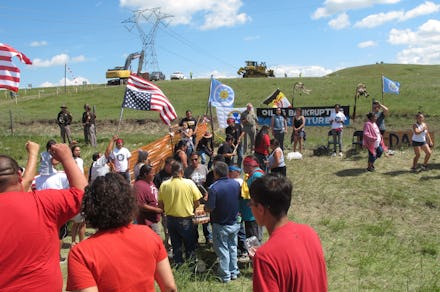Native American protesters stopped progress on the Dakota Access Pipeline

Nearly 400 protesters gathered to halt the construction of the Dakota Access Pipeline, a $3.8-billion system that, if completed, would stretch across North Dakota, South Dakota, Iowa and Illinois — rivaling the length of the rejected Keystone XL Pipeline. So far, 16 members of the Standing Rock Sioux Tribe have been arrested, including the tribe's leader, David Archambault II.
On Wednesday, Archambault contacted the White House and met with North Dakota senators to try to get construction halted on the 1,172-mile behemoth, planned by Texas-based gas company Energy Transfer Partners. Two days earlier, ETP filed a lawsuit for restraining orders against protesters and what are being called unspecified monetary damages, which U.S. District Court Judge Daniel Hovland granted.
Even though the pipeline itself wouldn't cut through any federally reserved indigenous land, tribal leaders pointed out that it disrupts sacred ground for the tribes, crosses over 200 rivers and creeks and comes within half a mile of a reservation, ostensibly affecting drinking water supplies for thousands of people.
"It's a historic place of commerce where enemy tribes camped peacefully within sight of each other," Jon Eagle Sr., Standing Rock Sioux Tribe's tribal historic preservation officer, told Indian Country Today. "In the area are sacred stones where our ancestors went to pray for good direction, strength and protection for the coming year. The stones are still there, and our people still go there today."
However, the restraining order against protesters gave the Energy Transfer Partners the right of way in construction, providing all of its permits were in order. Following the decision, construction was able to begin on a part of the pipeline that crosses Lake Oahe, near the Missouri River.
Still, Archambault believes protesters should still continue to defend the land by peaceful means. In the meantime, Archambault has urged President Obama to help, hoping the president and First Lady Michelle Obama's visit to the Standing Rock Indian Reservation in 2014 showed them the living conditions people on reservations have to deal with — even without a massive oil pipeline mucking things up.
"I believe both he and Michelle Obama were touched," Archambault said, according to the Rapid City Journal. "So now if there's any way he can intervene and move this pipeline off our treaty lands, I'm asking him."